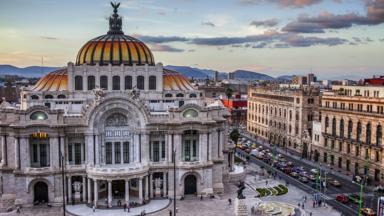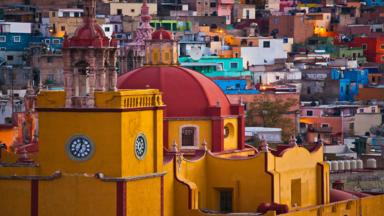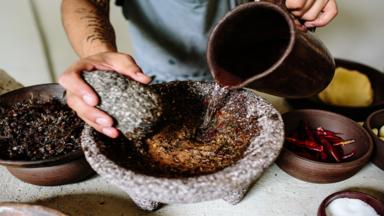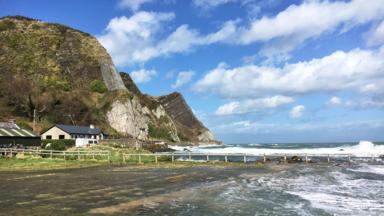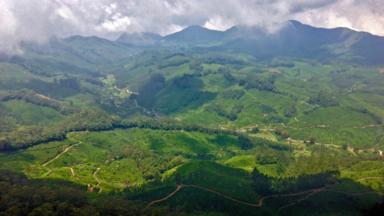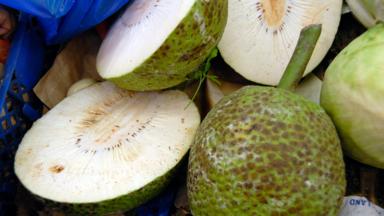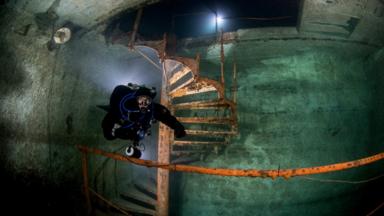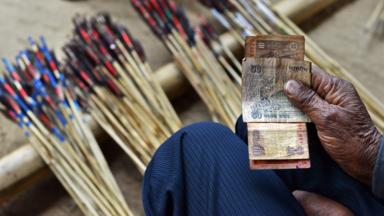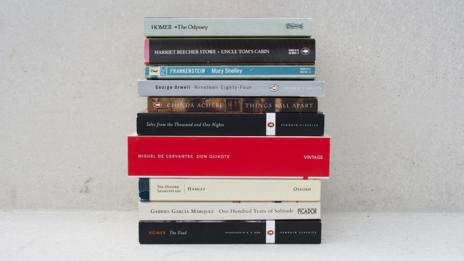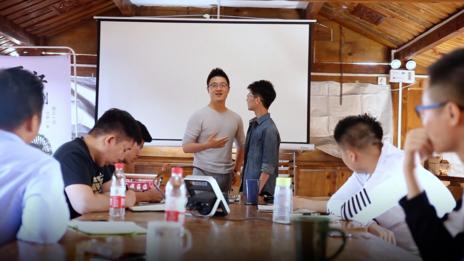A piece of Britain lost in Mexico – or – Finding where Britain Stole its Culture From?
- Food & Drink
To understand how a bit of British legacy can be found in Hidalgo, Mexico, we must look back two centuries to the heyday of Cornwall’s mining industry.
By Lauren Cocking
As I squeezed my way through the crowd, Marion Symonds was busy crimping one side of a 4.5m-long pasty in the central plaza. All eyes were on this Cornish baker as she held the still-malleable pastry shell in her hands, delicately crimping the edges of the dough with her fingertips to seal in the beef, potato and onion.
Looking at the sloping red roofs and manicured gardens around us, you’d have thought Symonds and I were somewhere in our native England. In fact, we were in the tiny town of Real del Monte in the central Mexican state of Hidalgo. At the other end of the oversized snack, a local chef was crimping the Mexican way, slapping the pastry shut with the side of a hand atop a table.
To understand why a giant Mexi-Cornish pasty was being made in an English-looking town in central Mexico, we must go back two centuries to what Bridget Galsworthy Estavillo of Mexico’s British Society calls ‘the backbone’ of the story: the arrival of Cornish miners in Mexico.
Real del Monte, Mexico’s sloping red roofs and manicured gardens are reminiscent of England (Credit: Getty Images)
You may also be interested in:
• A town that’s more British than Britain
• Where afternoon tea really came from
• The island more Scottish than Scotland
In the early 19th Century, Cornish tin miners were known around the world for their state-of-the-art mining equipment and, consequently, their expertise in operating it. As such, they and their advanced machinery were called to Mexico by the Company of Gentleman Adventurers in the Mines of Real del Monte to help mine silver, Galsworthy Estavillo told me. After landing in Veracruz on Mexico’s east coast in 1825, the first wave of Cornish miners made the 400km journey west to the Central Highlands of Mexico where they set to work extracting silver, simultaneously establishing tight-knit British communities and welcoming new waves of Cornish migrants practically each year up until 1840.
While Galsworthy Estavillo was quick to note that “the first wave [of Cornish miners didn’t come] out of desperation,” many later arrivals were driven by necessity, as a direct result of the discovery of tin in Bolivia and Malaysia in the 19th Century. This led to the closure of many of Cornwall’s tin mines and kicked off a severe economic slump that left miners with little option but to make their way to pre-established Cornish diaspora communities overseas, Mexico included.
As the miners established Cornish enclaves, they also began to cement their legacy in Hidalgo, introducing those oh-so-English sloping roofs and their beloved pasties.
In the early 19th Century, Cornish miners travelled to Real del Monte, Mexico, to mine silver (Credit: Three Lions/Getty Images)
But these aren’t the only reminders of Real del Monte’s centuries-old connection to the UK. According to Galsworthy Estavillo, ‘the pride of Real del Monte’ lies in the Panteón Inglés, known in English as the Cornish Cemetery, located on a hilltop overlooking the town. The cemetery, in which all but one of the graves face north-east towards England, is “quite unique. It’s beautiful, it’s poignant,” she told me. The single askew grave belongs to a Yorkshire-born mining engineer (not English clown Richard Bell, as local rumour might have you believe), and you can thank awkward tree roots for throwing it out of whack, Galsworthy Estavillo explained.
By the early 20th Century, Hidalgo had the most British transplants of any Mexican state, and Real del Monte isn’t the only town that bears the stamp of their influence. Roughly 14km west, in Hidalgo’s capital city of Pachuca, the Bancomer bank – one of several edifices funded by influential former Cornish miner Francis Rule – depicts six separate Union Jacks on the parapet, a design choice provoked by city officials who allegedly banned Rule from flying the actual flag outside the building. Yet Rule’s most recognised project is Pachuca’s striking Neoclassical clock tower, whose machinery was produced in the same Austrian factory as that of London’s Big Ben.
There’s one more enduring obsession for which Mexicans can thank the Cornish miners: football. The local custom of a quick kick-about at 16:00 likely originated with the miners in the late 19th Century. This informal appreciation of the game led to the turn-of-the-20th-Century birth of the Pachuca football club, whose original squad was replete with common Cornish surnames like Pengelly and Bennetts. Pachuca is now known as both the country’s cuna del fútbol (cradle of football) and home to the Salón de la Fama football museum, which charts the sport’s Mexican legacy.
All but one of the graves in Real del Monte’s Cornish Cemetery faces England (Credit: Carlos Enrique López C/Flickr)
But getting back to Real del Monte and that giant Cornish pasty, or paste, as it’s known in Mexico. The Cornish migrants couldn’t possibly go without their mineshaft meal of choice, a hearty blend of meat and vegetables wrapped up to-go in a savoury pastry shell strong enough to survive the journey into the tunnels. So their wives began recreating them in Hidalgo, eventually showing locals how to make the dish. In fact, Cornish pasties took such hold in Mexico that the tradition of passing them down the mineshafts for lunch endured in Real del Monte even as mines were being shuttered in their native Cornwall.
So it makes sense that each year, in the state that is home to the world’s first pasty museum, local paste makers line the streets as part of the Festival Internacional del Paste to celebrate the Cornish diaspora’s delicious legacy. Eager visitors from across Mexico snap up boxes full of pastes, while Union Jacks and flags bearing the black-and-white Cornish cross flutter in the breeze. Even 8,000km from the UK, I felt somewhat at home – minus the fact I was slurping down a michelada, a spicy, tomato juice-based Mexican beer cocktail.
The bell tower in Pachuca, Mexico, is equipped with the same machinery as London’s Big Ben (Credit: Sergio/Mendoza Hochmann/Getty Images)
Symonds, who is based in Cornwall but travels regularly to Mexico, is known in Real del Monte as the ‘Mother of the Pasty’, a nickname bestowed upon her by the ‘Father of the Pasty’ and Festival Internacional del Paste founder, Victor Aladro, thanks to her involvement in organising a similar pasty celebration in Cornwall.
“The law of a Cornish pasty is that it has to have potato, swede, onion and beef. The pastry needs to be firm enough to hold in your hand, and you need to have lots and lots of pepper,” she told me.
The Mexican paste remains remarkably akin to its Cornish forebear, despite the passage of 200 years. The crusts are similar, though Symonds notes that Mexicans use their pastry straight away rather than letting it sit for a day, as the Cornish do. The fillings are where the regional variation is most notable. Due to Mexico’s preference for spicier flavours, and the fact that cultivating swede (a common ingredient in Cornish pasties) there is impossible, Mexican pastes use traditional Mexican fillings like mole (a spicy chocolate and chilli sauce) or tinga (shredded meat marinated in tomato and chipotle pepper sauce). Even classic meat-and-potato pastes have a spicy kick to them, thanks to the addition of poblano chilli peppers or jalapeños.
The Cornish miners introduced the pasty to residents of Real del Monte, where it remains a popular snack (Credit: Jim Richardson/Getty Images)
Today, Real del Monte is part of the Mexican government’s tourism-boosting programme of pueblos mágicos (‘magic towns’) in Mexico. But no matter how many spicy chilli-stuffed pastes I wolfed down against the town’s dramatic mountainous backdrop, the illusion that I was wandering the streets of a quaint English town was tough to break; after all, those sloping roofs, well-kept gardens and pasty shops don’t lie. The Cornish influence endures.
Join more than three million BBC Travel fans by liking us on Facebook, or follow us on Twitter and Instagram.
If you liked this story, sign up for the weekly bbc.com features newsletter called “If You Only Read 6 Things This Week”. A handpicked selection of stories from BBC Future, Earth, Culture, Capital and Travel, delivered to your inbox every Friday.
Editors’ Picks
-

To the Ends of the Earth
-

Culinary Roots
-

Why We Are What We Are
-

Travel Journeys







